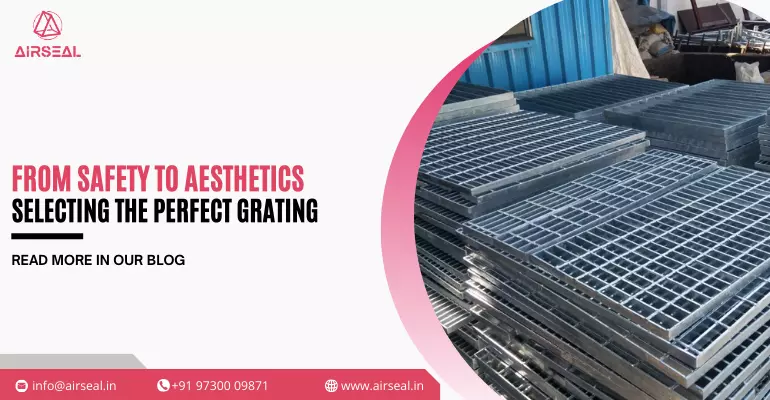
Grating Materials: Choosing the Right One for Your Project
Selecting the right materials for your project is pivotal, especially when it comes to components like gratings. These unassuming elements play a crucial role in various industrial and commercial applications, from providing sturdy walkways to ensuring safe platforms.
At Airseal Technology LLP, we understand the significance of choosing the right grating material, and we're here to guide you through the process.
Airseal Technology LLP is a distinguished player in the thermal power plant industry, renowned for offering an extensive range of high-quality gratings for diverse applications. With cutting-edge facilities and a capacity to produce over 50 metric tons of grating panels daily, we stand ready to meet our clients' most urgent needs. Our commitment to efficiency means we can deliver ready-to-dispatch grating panels on short notice.
II. Types of Gratings
Electro Forged Gratings
Electro-forged gratings, recognized for their robustness and durability, are the go-to choice for heavy-duty industrial applications. They find their home in settings like oil and gas refineries, power plants, and chemical processing facilities. Their tight and compact structure, crafted through a high-temperature forging process, renders them highly resistant to impact and corrosion. Additionally, they boast an impressive load-bearing capacity, making them ideal for areas with heavy machinery and vehicle traffic.
Manual Punching Gratings
Manual punching gratings offer a cost-effective alternative for applications with less demanding requirements. They frequently grace walkways, stair treads, and mezzanine flooring in commercial and industrial buildings. These gratings are also well-suited for pedestrian bridges, decks, and ramps. Although they may not match electro-forged gratings in load-bearing capacity, they can handle moderate loads and pedestrian traffic with ease.
Serrated Gratings
Serrated gratings are tailor-made for outdoor environments, where additional slip resistance is paramount. Bridges, decks, ramps, and walkways benefit from the added traction serrated gratings provide. They're also invaluable in industrial settings where workers face the risk of slipping, especially on wet or oily surfaces. The serrations on their surface significantly reduce the likelihood of accidents and injuries.
Plain Gratings
Plain gratings, with their smooth and unadorned surface, are the preferred choice for indoor applications. In buildings and areas where a smooth surface is essential, such as stair treads, mezzanine flooring, and walkways, plain gratings excel. They are also a safe bet for areas free from heavy machinery and vehicles. Their smooth surfaces not only provide an easy-to-clean and maintain solution but also prevent the accumulation of dirt and debris.
III. Factors to Consider When Choosing Grating Materials
The choice of grating material isn't just about picking the one that looks best; it's about functionality, safety, and longevity. Here are some key factors to consider when making your selection:
Load Rating and Span Length: Different projects demand different load-bearing capabilities. Consider the load your grating will need to support and the span length it will need to cover. Electro-forged gratings, for example, are known for their ability to handle heavy loads.
Material Quality and Fabrication Method: The quality of the material used in your gratings is critical to their durability. Different fabrication methods also affect the strength and longevity of the gratings. Be sure to consider these factors when making your choice.
Surface Treatments and Safety Features: Safety should always be a priority. Some gratings come with serrations to enhance traction, making them suitable for areas prone to slipping hazards. Others may have specialized coatings to improve their corrosion resistance and increase their lifespan.
IV. Tips for Choosing the Correct Steel Gratings
To help you make an informed decision, here are some tips for choosing the right steel gratings:
Consider the Expected Use: The application of the grating is paramount. Will it be installed in an industrial setting, a commercial building, or an outdoor environment? Understanding the expected use helps determine which grating type is the best fit.
Choose the Right Material: Different materials have unique characteristics and applications. Make sure your choice aligns with your project's specific requirements.
Determine Carrying Capacity: The pitch of the grating - the distance between bearing bars - is a key factor in determining its carrying capacity. For heavy machinery or pedestrian traffic, a suitable pitch ensures the grating can safely support the intended loads.
V. Comparison of Steel and Fiberglass Gratings
Steel gratings have their own strengths, as do fiberglass gratings. Here's a comparison to help you decide between these two materials:
Pros and Cons of Each Material: (In table format)
Steel Gratings:
Pros: Known for their high strength, durability, and load-bearing capacity. Highly resistant to impact and corrosion.
Cons: Can be heavy, may require more maintenance, and are susceptible to rust without proper surface treatment.
Fiberglass Gratings:
Pros: Lightweight, corrosion-resistant, and electrically non-conductive. Require minimal maintenance and have good impact resistance.
Cons: May not have the same load-bearing capacity as steel gratings, and they can be less durable in some heavy industrial applications.
Factors to Consider When Choosing Between the Two:
Application: Determine where the gratings will be used. Steel gratings are typically better suited for heavy industrial environments, while fiberglass gratings excel in areas where corrosion resistance and low maintenance are critical.
Load Requirements: Consider the weight the grating will need to support. For projects with heavy loads, steel gratings may be the more suitable choice.
The selection of grating materials is a vital aspect of any project, and it shouldn't be taken lightly. Your choice should be informed by the specific requirements of your application. Whether it's steel or fiberglass, the right grating ensures safety, functionality, and longevity. Keep these tips in mind to make the best choice for your project, and remember that the material you choose plays a significant role in the success of your venture.

